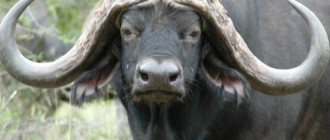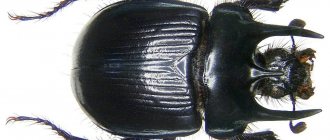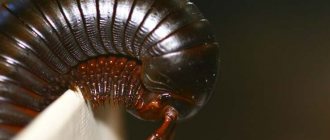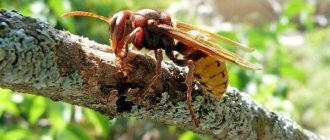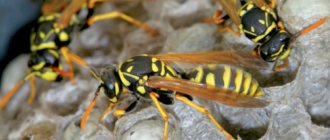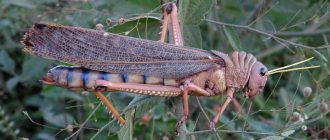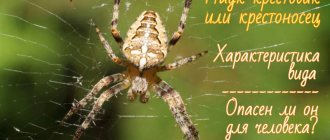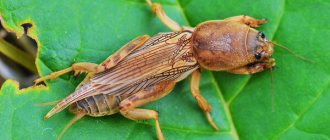- Wild animals
- >>
- Mammals
Bat has long inspired a person with horror. Many legends and stories have been invented around their unusual lifestyle and appearance. Their sharp teeth and nocturnal flights combined have created the illusion of potential danger when faced with them. However, in reality, everything is not so, and only a few rare species that live in certain places feed on the blood of large mammals. The rest are content with insects and have nothing to do with vampirism.
Bat - description, structure. What does a bat look like?
The order of bats, to which bats actually belong, is especially remarkable in that they are, in fact, the only mammals capable of flying. Here, however, the squad of bats includes not only flying mice, but also other no less flying brothers: flying dogs, flying
foxes, as well as fruit bats, which differ from their counterparts - ordinary bats, both in their habits and in body structure.
As we mentioned, bats are small in size. The weight of the smallest representative of this species, the pig-nosed flying mouse, does not exceed 2 grams, and the body length reaches a maximum of 3.3 cm. In fact, it is one of the smallest representatives of the animal kingdom.
The largest representative of the bat family is a giant false vampire, weighing 150-200 g, and a wingspan of up to 75 cm.
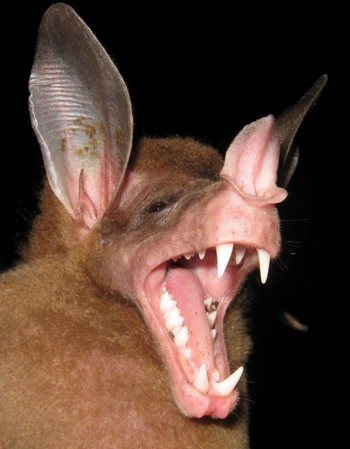
Different types of bats have different skull structures, the number of teeth also varies and depends a lot on the nutrition of a particular species. For example, a tailless long-lingual leaf-nose that feeds on nectar has an elongated facial part. Nature so wisely did so that he had where to accommodate his long tongue, which in turn is necessary for getting food.
But predatory bats that feed on insects already have the so-called heterodont dental system, which includes incisors, canines and molars. Small bats that eat even smaller insects have up to 38 small teeth, while large vampire bats have only up to 20. The fact is that vampires do not need many teeth, since they do not chew food. But they have sharp fangs that make a bleeding wound on the victim's body.
Traditionally, bats, and of almost all species, have large ears, which are responsible, among other things, for their amazing echolocation abilities.
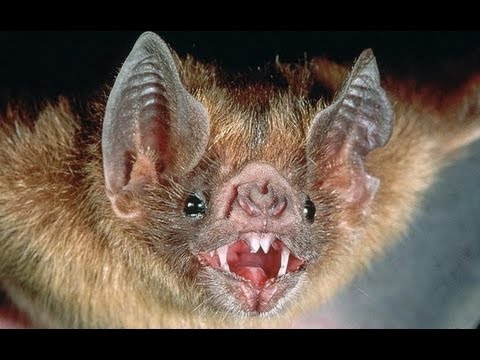

The forelimbs in bats have been transformed into wings in the course of a long
evolution. The elongated fingers began to serve as the frame of the wing. But the first finger with a claw remains free. With its help, flying mice can even eat and perform various other actions, although in some of them, such as smoky bats, it is not functional.
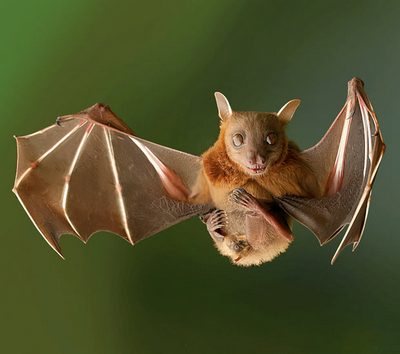

The speed of a bat depends on the shape and structure of its wing. They, in turn, can be very long, or vice versa with a slight elongation. Wings with a lower aspect ratio do not allow you to develop high speed, but you can maneuver with them perfectly, which is very useful for bats living in the forest, and which often have to fly among the crowns of trees. In general, the flight speed of a bat ranges from 11 to 54 km per hour.But the Brazilian fold-lip, from the genus of bulldog bats, is the absolute record holder for flight speed - it can reach speeds of up to 160 km per hour!
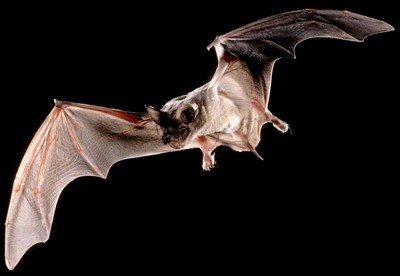

The hind limbs of bats have a characteristic difference - they are turned to the sides by the knee joints back. With the help of well-developed hind legs, bats hang upside down, in this seemingly (as for us) such an inconvenient position they sleep.
Bats, like all decent mammals, have a tail, which also comes in different lengths depending on the species. They also have bodies (and sometimes limbs) covered with wool. The coat can be flat, shaggy, short or thick, again depending on the species. The color also varies, usually whitish and yellowish shades prevail.
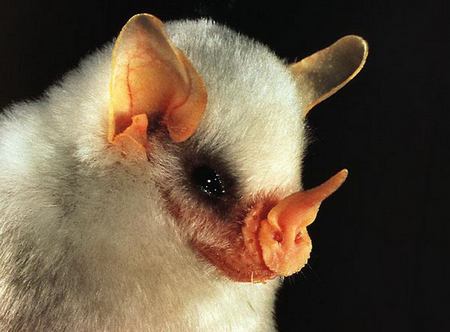

Honduran white bat with a very unusual coloring - the white coat contrasts with the yellow ears and nose.
However, there are also representatives of bats, with a body completely without hair - these are two bare-skinned bats from Southeast Asia.
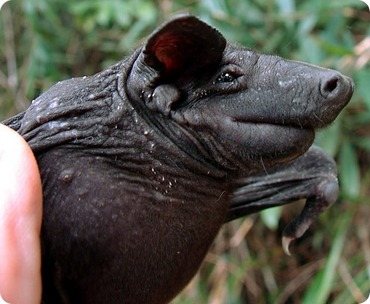

Vision in bats leaves much to be desired, eyes are poorly developed. In addition, they do not distinguish colors at all. But poor eyesight is more than compensated for by excellent hearing, which, in fact, is the main sense organ in these animals. For example, some of the bats can catch the rustle of insects swarming in the grass.
Their charm is also well developed. For example, females of the Brazilian foldlip by smell are able to find their cubs. Some bats smell their prey by smell, as well as by hearing, and can also distinguish between "their" and "alien" bats.
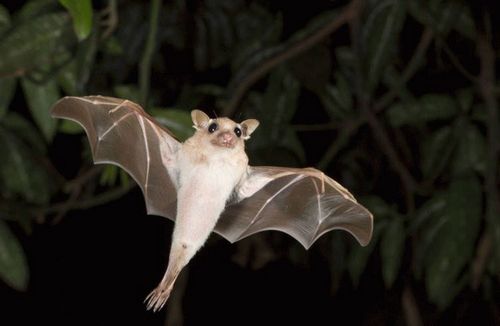

Cognitive resource about culture, science and art
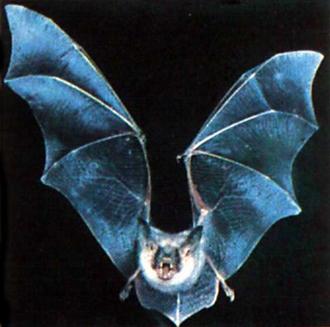

Sergey KuriyArticle from the rubric "Cultural Zoology"
“- Are you mice? - Volatile, sir! “If you’re mice, then you don’t like cats either?” "We can't stand it, sir!" (From mf "Dog in Boots")
As for the cats, the cartoon characters may be right. Cats, indeed, are sometimes capable of accidentally catching gape gray flyers. However, this fact does not at all make them "mice". Especially annoying is the name "bats" of zoologists. It is bad form to use it in professional scientific literature. The competent name for this order of mammals is bats, and its closest relatives are not rodents at all, but insectivores (which include hedgehogs and shrews).
Actually, bats originated from insectivores. The earliest (found) remains of bats belong to the Eocene epoch (50 million years ago) and already have a familiar appearance. Therefore, when the animals decided to conquer the air element is still unclear. But it is clear how and why they did it.
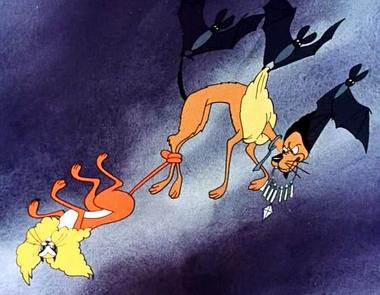

Can you compete with birds?
“The cats are dragging their pitiful lot, vegetating on the ground. And we soar freely in the sky Above the Pas-de-Calais In the misty, sleepy haze.
The task of Proudly soaring under the clouds is too tough for cats. Our glorious family on the cat rabble Looks down, gloating slightly. " (Song of bats from the movie "Dog in Boots")
As you know, at first flying lizards began to hunt for fluttering insects, then they were replaced by more skillful aviators - birds. But birds (with rare exceptions, like owls) hunted only during the daytime, and the "night shift" remained practically free. It was taken by the ancestors of the bats. It is not without reason that some species of bats have been nicknamed by people - noctresses, bat.
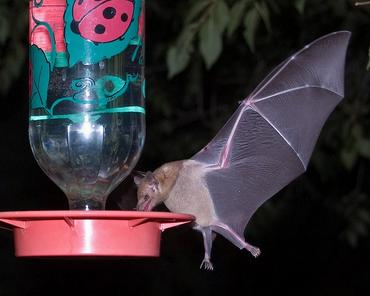

By the way, it is believed that the name "bats" appeared in Russian only in the 18th century, as a direct translation of the German "Fledermaus". Before that, bats in Russia were usually called "bats". There is still debate about the origin of this word. Some believe that it is formed by the Greek word "nekto" (night) and the Old Russian "rut" (to soar). Others say that "bat" means "no feather".Still others, that at first it was written as "nepetr" and meant "not a bird."
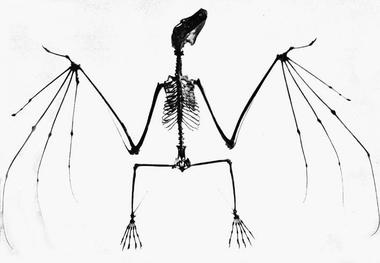

Indeed, a bat's wing cannot be confused with a bird's. True, there are also similarities. For example, the skeleton of bats also has a keel - a protrusion on the sternum, to which the flight muscles are attached - however, it is smaller than in birds. The bones of bats, although not hollow like those of birds, are very thin (the thinnest among mammals) and at the same time strong. If in birds the wing is formed by only one elongated finger, then in bats all fingers except the “thumb” have become such (they use it as a claw for climbing).
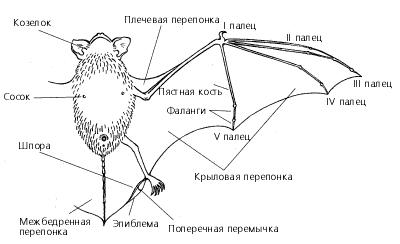

Stretched between these fingers is an elastic skin membrane that extends along the sides of the body up to the hind limbs and tail. This feature is perfectly reflected in the Ukrainian language, where all bats are called "kazhans".
| Joke:“There are two ordinary mice from the disco, and one says: - Today such a cool boy came to me, handsome, all in leather ... - Well, this is a bat! - And he said - a pilot ... ". |
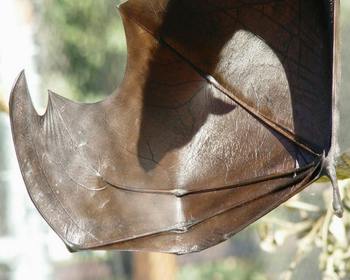

Of course, the leather membrane is far from the aerodynamic properties of feathers. But thanks to its flexibility, bats have become one of the most maneuverable flyers, capable of abruptly and quickly changing direction of flight. Catching a bat in the air is difficult. Therefore, people have long been using the following method - stretching a white sheet on the ground. Insects immediately flock to the light surface, followed by bats. I don’t know how effective it is - I haven’t tried it ... Bats generally have very few natural enemies - mostly the same owls and people.
But the flying lifestyle has its drawbacks as well. First, flying requires a high metabolism, and therefore a lot of food. As a result, bats have to feed at a rate of 500-600 insects per hour. When you have to sleep or spend the winter, the metabolism slows down dramatically.
Bats spend the nights and wintering in dark secluded places - caves, hollows, cracks in walls, in attics, even in burial vaults (one of the species found in the Egyptian pyramids is called the burial bag wing). Sometimes huge flocks gather in one place. For example, more than 20 million bats nest in the Bracken Cave (USA).
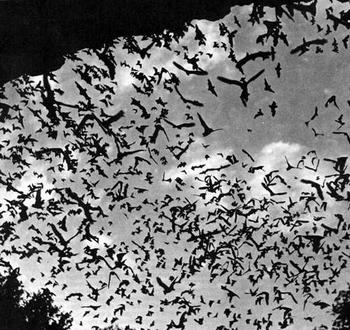

A person caught in such a place may well lose consciousness from the "bouquet" of odors from urine, guano and decaying remains. Arriving "home", bats cling to the walls and ceilings with their hind legs, and so they sleep - upside down. In this case, the fingers "automatically" are compressed, and the bats cannot fall in a dream.
| Jokes: “Bats are hanging on the bar. Suddenly one turns head up. The other looks at her with great surprise and asks the third: - Listen, what's wrong with her? - Yes, don't pay attention. Again I lost consciousness. " “There is a bunch of bats hanging from the ceiling — everything as it should be, and one with its head up. Mice hanging in the neighborhood are talking: - Why is she hanging upside down? “Ah, he’s doing yoga!” “Two bats are hanging and talking: - What was the worst day in your life? - Yes, when the diarrhea began! “Two bats hang from the ceiling and examine the cavers. - Listen, have you ever wondered why their blood does not rush to their legs? |
Already during a regular overnight stay, the body temperature of a bat drops by 15-20 degrees. Well, during hibernation, it does not rise above 10 degrees at all. If the ambient temperature drops below zero, water droplets collect on the mouse's body and form a protective ice crust.
The next disadvantage of the flying lifestyle is associated with live birth. If the birds are relieved of the burden by laying eggs, then the pregnant bat has to flutter with the embryo in its belly. Although these animals are quite strong (capable of lifting a load of 3/5 of their own weight), it is not profitable to bear more than one cub.During the Second World War, the Americans tried to use the carrying capacity of bats against the hated Japanese. They planned to attach phosphoric bombs to the animals and release them off the coast of Japan. In theory, the mice were supposed to scatter around the buildings and provoke fires. True, during the experiment, frightened animals burned down an entire test hangar. The bats were recognized as uncontrollable and the project was shut down.
A similar fate awaited the idea of an aircraft built in the image and likeness of a bat's wing. For the first time this idea was expressed by Leonardo da Vinci back in 1503 and even drew sketches. In practice, the fantasies of the great artist were tried to be realized by the French inventor Clement Ader in 1886-92. True, for reliability, he supplemented the wings with a steam engine. Did not help. Ader's devices flew close, not for long, and the latter crashed altogether ... It turned out that copying a bat is far from easy.
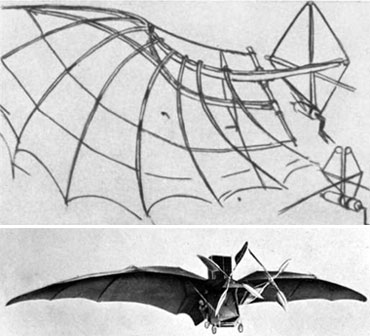

Da Vinci's sketch and Ader's aircraft "Avion".
The most amazing "invention" of nature was the ability of bats to fly skillfully and hunt accurately in complete darkness. And this topic deserves a separate story ...
A space woven of sounds
“A bat flies in the dark and crashes into a wall from all over the place. Sits downstairs, scratching his head: - Damn, I'll kill myself with this player someday. (joke)
In 1793, the Italian scientist Lazaro Spallanzani discovered an amazing fact. He found that two nocturnal flies - an owl and a bat - behave completely differently when they find themselves in a completely dark room. The first does not even try to take off, but the second flies confidently, as if her eyesight is of no use. The scientist was finally convinced of this when he glued the bat's eyes.
The bat skillfully maneuvers between the turns of the wire.
A year later, the second scientist - Swiss Charles Juran - repeated and confirmed Spallanzani's experiments. And also found out something new. It turned out that the mouse really "went blind" only after it was flooded with wax in its ears. Does this animal really use hearing to navigate in the dark? But how can you "hear" a motionless obstacle like a wall? Unclear. It is not for nothing that Juran's conclusions were not taken seriously by the rest of the scientific community.
| Montagu, 1809:“To agree with the conclusions that Jurine draws from his experiments that the ears of bats are more important to them than the eyes, in the detection of objects, it takes more faith and less philosophical meaning than one would expect from a zoologist-philosopher who could to ask, if bats see with their ears, do they hear with their own eyes? " |
A major authority among naturalists - the Frenchman Georges Cuvier - even stated that Jurin's experiment was too cruel. They say that the wax in the ears of the animals not only deprived them of hearing, but also produced a general traumatic effect, from which they became helpless. Instead, Cuvier put forward another - seemingly more logical - hypothesis. In his opinion, bats have a kind of sixth sense - the so-called. touch at a distance - and are able to navigate by the air currents reflected from obstacles. As with the "catastrophe theory" (an alternative to Lamarck's evolutionary theory), the great naturalist was wrong.
However, this became clear only at the beginning of the twentieth century. In 1912, the British inventor Hiram Stevens Maxim (the one who created the machine gun of the same name) was, like many, shocked by the catastrophe of the Titanic liner. Then he proposed using the echolocation method during the voyage, so that, by the reflected sound signals, it would be possible to prevent the collision of the ship with a large obstacle like an iceberg. At the same time, Maxim expressed the idea that, most likely, bats also use this method.True, he assumed that for orientation, these animals send infrasounds (sounds of an inaudible low register) into space, which they emit with the help of wing flaps.
In 1920, the idea of Maxim was supported by the British neurophysiologist - H. Hartridge - with the clarification that the “echo sounder” of the bat “works”, rather, not on infra-, but on ultrasounds (that is, in the inaudible upper register).
However, experimentally these guesses were confirmed only in 1938, thanks to two employees of Harvard University - physicist George Pearce and his student Donald Griffin. Pierce developed an electronic device capable of capturing ultrasounds, and Griffin thought of bringing a cage with bats to the device. A deafening crack was heard from the speakers. It turned out that the night hunters are not as silent as they seemed.
| Jan Lindblad "In the Land of the Hoatsin":“You turn on the light - immediately thousands of wings begin to flicker. And then something unexpected happens: the air temperature in the cave rises rapidly from all this hectic activity! We hear only the rustle of wings, but in reality a monstrous choir sounds in the underground monastery; it is good that frequencies from 30 thousand to 100 thousand hertz are not perceived by the human ear ”. |
Griffin and Pierce took up bats closely and made many more discoveries. For example, they found that animals lose their ability to navigate when they are deprived of not only hearing, but also the ability to publish it. In general terms, the "echo-finder" of bats worked like this. In flight, the bat emits the finest ultrasonic squeaks. The sent signal is reflected from the obstacle, picked up by the ears, and the animal determines the distance to the object by the time of its delay. The closer the object is, the greater the frequency of the signals sent - the mouse, as it were, brings "sharpness".
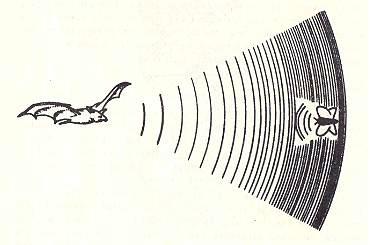

The bats ultrasound analyzer impresses with its accuracy and processing speed. First, bats must distinguish their signals from extraneous sounds. Secondly, they are able to catch with their sound "scanner" even a wire no more than a millimeter thick. Yes, that there is a wire! - a fly that also moves.
| David Attenborough "Life on Earth":“Under the vault of the cave, undoubtedly, several hundred thousand of them swirled like a black storm. And each, probably, at the same time worked with her sonar. How could their signals not intersect with each other, were not distorted, not extinguished? How did the animals react so quickly to the information they received and avoid collisions at such a speed? Being there, you see with your own eyes what immense complexity of tasks is solved by navigation with the help of echolocation. " |
Echolocation also has its drawbacks. First, sound is scattered over long distances. Therefore, mice first scan their permanent home (be it a cage or a cave) in detail, and then usually use the resulting picture from memory. For example, when scientists changed the location of the door in the cage, the animals for some time out of habit poked at the old exit until they noticed something was wrong. It is also known that sounds are well muffled by soft, rough surfaces. Therefore, many moths have a shaggy body, which is difficult to distinguish for the "sonar" of bats. Perhaps for the same reason, bats often get entangled in lush female hairstyles.
These animals have another problem. If you look at the gallery of different species of bats in full face, then, most likely, you will think that these terrible chimeras flew straight from the paintings of Bosch. Why bats need big ears is understandable. But why do they need such ugly noses - with growths and the most bizarre shape? The fact is that when a prey gets into a bat's mouth, it loses its ability to squeak for some time. Therefore, many bats began to use the nose as an additional resonator. In addition, each species has its own nose and its own sound, which, you see, is also important.It is not for nothing that the names of some species are very eloquent - slit-mouth, horseshoe-nose, smooth-nosed, spear-nosed and even folded-faced leaf-nosed.
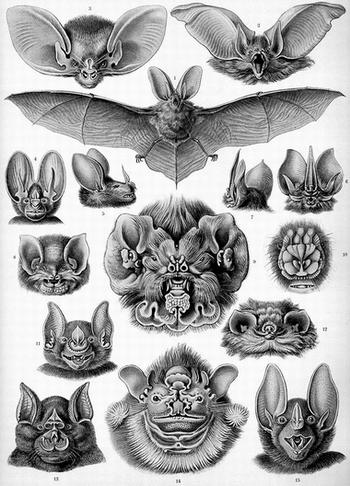

By the way, the eyes of bats, although small, are far from superfluous. As perfect as echolocation is, in the presence of light, animals prefer to rely on vision. When in 1946 the biologist A. Kuzyakin released bats during the day, half of them began to beat against the glass with the blindness of a fly. When they closed their eyes, the sonar started working at full power, and the animals stopped making mistakes.
Do mice eat cats?
"Hello, I am your mouse, I am your mouse And I will eat you ..." (from the song of Philip Kirkorov)
The order of bats has about a thousand species (17% of the total species diversity of mammals) and, in terms of this indicator, is inferior, perhaps, to the ubiquitous order of rodents.
Not all bats have developed echolocation. First of all, it depends on the way of eating. The most complex and high-frequency signals are emitted by insectivorous bats actively hunting.
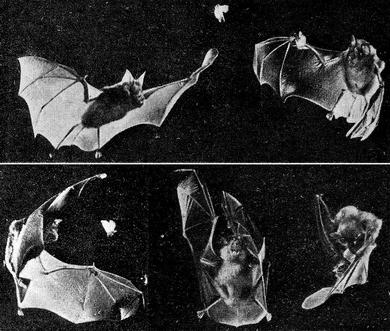

Less active horseshoe bats have a lower frequency and length of ultrasound. These mice hunt, as it were, from an "ambush" - they hang on a branch and "scan" the surrounding space in search of prey. And after the target is found, they rush after it in pursuit.
There are bats and fish-eating fish that live in South America. Their flying membrane does not reach the tail. It ends at the knees, leaving the clawed hind legs free. With the help of their mouse and catches his fish. Scientists argued for a long time about the role the sonar plays in night fishing, and in the end they decided that it reacts, first of all, to splashes of water and fish that emerged to the surface.
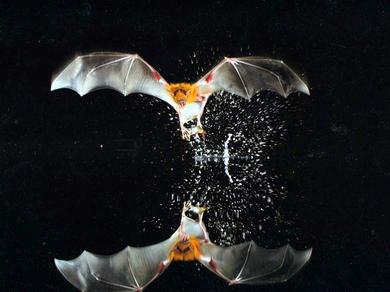

Fish-eating bat.
The weakest sonar units in the bats have bats. In popular literature, this group of bats is often called flying dogs or foxes. Although, for example, to James Cook, these cute creatures at one time seemed like the devil!
| James Cook, 1770:“This is the most peculiar animal, notable for its large size and resembles a keg with a capacity of up to one gallon (4.54 liters). It is black like the devil and has wings; and I really took him for the devil, otherwise I could easily catch him, as it was crawling very slowly on the grass. " |
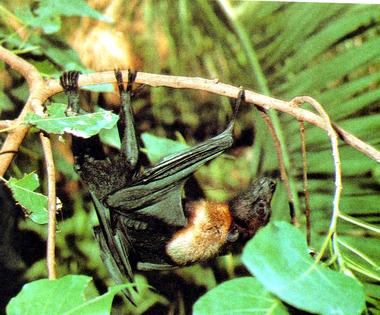

The muzzles of flying foxes with small ears and unusually large (for other bats) eyes really resemble foxes. And the size is impressive. The body length of the largest fruit bat, the Kalong, is 40 cm, and the wingspan reaches one and a half meters. When a flock of fruit bats rests upside down on the branches of a tree, it seems from afar that someone has hung several dozen "Caucasian captives" on it in sleeping bags.
The flight of fruit bats does not at all resemble the restless fluttering flight of insectivorous bats. Measuredly, without haste, they flap their wide wings. Ultrasonic location in flying foxes is the weakest among bats. But in the audible range, they are very loud - so much so that sometimes they drown out the noise of traffic.
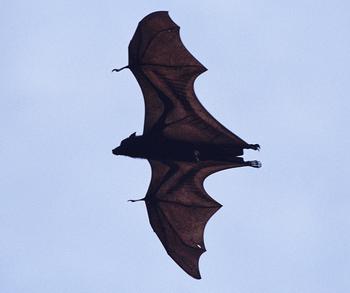

The underdevelopment of echolocation is explained by the fact that flying foxes, despite the name, are convinced vegetarians, and the plants will not run away from them. The diet consists of juicy fruits that grow in tropical regions of Asia, Africa, Australia and Oceania.
The most bizarre bats - the hammerhead - for more successful swallowing of fruits, acquired such a huge muzzle that it looked not like a fox, but some kind of mutant dog.
Those with a smaller muzzle and size were re-profiled into "butterflies". They flutter over flowers and lick off pollen and nectar with long tongues, and at the same time perform a useful function of pollination. Nectarivorous bats include not only fruit bats, but also certain species of the so-called. leaf-noses.
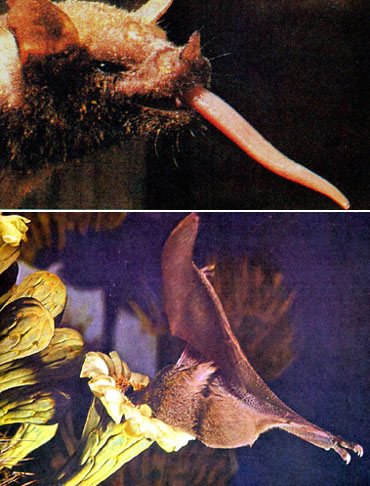

Leaf-nose.
However, not all bats are so harmless ...
Remember how the heroine of the fairy tale "Alice in Wonderland" reasoned on the topic: "Do cats eat midges?" Do midges eat cats? " In fact, the "gnats" in the fairy tale appeared, thanks to the translation of N. Demurova. In the original, everything looks more “logical”: “Do cats eat bats? Do bats eat cats? " ("Do cats eat bats? Do bats eat cats?"). To keep the rhyme, the translator had to sacrifice accuracy.
Before answering Alice's question, you need to decide - in what sense do they "eat"? Among bats, there are indeed predators who prefer to devour a small bird or animal (including their small brother) instead of an insect. For example, an ordinary spearman or an Indian false vampire.
But among the bats there are also real vampires - the so-called. desmonds capable of encroaching on large prey such as a horse or a cow. Naturally, vampires do not devour them, but, like their mythical namesake, suck the victim's blood. Thus, being the only parasites among warm-blooded animals. These bats also attack people, but, they say, extremely rarely. True, the traveler Percy Fossett would argue here ...
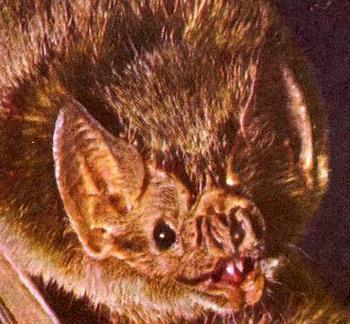

Smile of a vampire.
| Percy Fossett "An Unfinished Journey":“We reached a mountainous area, and at night vampires began to harass us. Todd, Vargas and I had bitten head and toes, Kostin had all the tips of his fingers injured on one hand. When we woke up in the morning, we found that our hammocks were soaked in blood, as every part of the body that came into contact with the mosquito net or protruded from under it was attacked by these disgusting animals. It is a mistake to think that they never harm a person. One night, I myself observed the behavior of a vampire attacking me. Before sitting down, he wrapped his wings around my face for a while, these movements produced a calming effect, and it took me a lot of effort to throw this creature away from me. I noted with interest that at that moment I had only one desire - to fall asleep and not oppose it. " |
On the hunt, a vampire, as befits an evil bloodsucker, flies out at night - usually in the company of his own kind. It flies quite low (at an altitude of 0.5-1.5 m) and relies more on smell and hearing in search of prey. Echolocation of a vampire is stronger than that of fruit bats, but weaker than that of insectivorous bats. However, these ultrasonic signals are enough for the dogs to smell the bloodsucker, which is probably why they are bitten less often than the others.
Having found the victim, the vampire sits on its back, or creeps up "on foot", leaning on the base of the hand (at this moment it resembles a frog jumping on the ground). With sharp incisors, the bloodsucker cuts the skin and begins to lap the protruding blood. Since several vampires usually attack one cow at once, at the end of the meal, up to thirty cuts can be counted on its body.
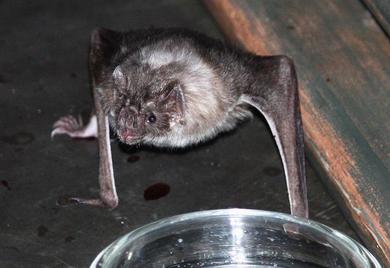

Vampires should eat regularly. One daily hunger strike immediately leads to a loss of 17% of weight, and two - to death. As a result, one vampire drinks at least 7.3 liters of blood per year. However, gluttony is not so bad. First, vampires can tolerate rabies, plague, and encephalitis. Secondly, in order for the victim to behave calmly, the saliva of the vampires anesthetizes the site of the bite and at the same time does not allow blood to clot. As a result, the wounds bleed and fester for a long time, attracting crowds of blood-sucking mosquitoes and flies. Well, they will not miss the moment to put their larvae there. Well at least the cows after these bites do not turn into vampires themselves ... :)
Witch or angel? Bird or beast?
“Witch or angel, Bird or beast, Come back - I'll leave the window open And the door unlocked. Death or salvation, Light or darkness, If you do not return, for the first time I will know How they go crazy.
But if you are even a moment late, Glasses will crack like ice, and a snow-white old man will fall to the floor, And the stone in the claws will become gray lead, And you will collapse powerlessly, breaking your wings, Next to a dead face. " (From the song of the group NAUTILUS POMPILIUS "The Bat")
Let's close our eyes for five seconds and say "bat" ... I am sure that almost all the associations that arose with these words will easily fit into one of three categories.
The first thing we identify with bats is, of course, Night and Darkness.The ancient Greeks called these animals - Nikterids, because bats were considered the daughters of Necta, the goddess of the Night. In addition, they were also the sacred animals of Persephone - the wife of the god of the afterlife kingdom, Hades. As you know, this kingdom was underground, so it did not resemble a shining Christian paradise, and the souls of the dead wandered there in the form of sad ethereal shadows. That is why Homer in his Odyssey compares these souls with bats rushing about in a cave.
In the Christian era, bats' devotion to darkness and fear of light quickly transferred them into the category of evil spirits. In Russia, a bat that flew into a house was always considered a bad omen. Bats become constant companions of witches and sorcerers, constant participants in the Sabbath. Moreover, artists often began to reward the devil himself with webbed wings. I must say that the appearance of the bats fit well with the devil's bestiary.
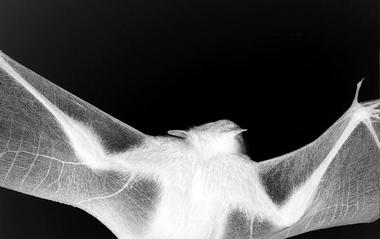

| Even the French naturalist of the 19th century - Alphonse Toussaint - could not resist the following passages:“A bat is a chimera, a monstrous impossible creature, a symbol of dreams, nightmares, ghosts, a sick imagination ... The universal irregularity and monstrosity seen in the body of a bat, the ugly anomalies in the senses that allow an ugly animal to hear with its nose and see with its ears - all this , as if on purpose, adapted to ensure that the bat was a symbol of mental disorder and insanity. " |
Bats are also a symbol of the dark, painful, unconscious imagination in Francisco Goya's famous engraving "The Sleep of Reason Gives Monsters". The artist himself explained the meaning of his painting as follows: "When the mind sleeps, fantasy in sleepy dreams gives rise to monsters, but in combination with the mind, fantasy becomes the mother of art and all its wonderful creations."
F. Goya "The Sleep of Reason gives rise to monsters", 1797.
The bat is still one of the favorite symbols of everything occult and otherworldly. A big fan of such paraphernalia was the rock singer Ozzy Osbourne - from which in 1982 he suffered. At the concert, one of the fans threw a bat on the stage of the idol. Deciding that it was a rubber toy, "great and terrible" Ozzy put it in his mouth and, making terrible grimaces, bit off her head. And then suddenly I realized that the animal is real ...
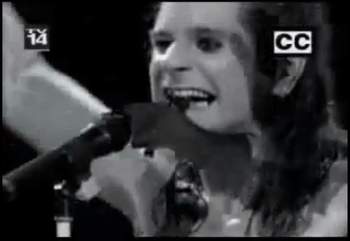

| Ozzy Osbourne:“I was given rabies vaccinations after I bit off the head of a bat. But it's okay. After all, the mouse had to be vaccinated against Ozzy. ... I am not proud to have bitten off the head of a bat. But it could have been worse. I could have been born Sting. " |
As for the notorious vampires, they did not immediately become identified with bats. At first, the revived dead bloodsuckers were on their own. True, when blood-sucking bats were discovered in South America, they were also called vampires, but they were never included in the vampire mythology itself. Everything changed in 1897, when the famous novel by B. Stoker about Count Dracula hit the shelves.
| Bram Stoker "Dracula":“He can turn into a wolf, as we know from the ship's arrival at Whitby when he tore the dog apart; he can be like a bat, as evidenced by Madame Meena, who saw him in the window at Whitby, and friend John, who saw him flying out of the next house, and friend Quincy at Miss Lucy's window. " |
From that moment on, mythical vampires were firmly associated with bats. So much so that even Tolkien in his "Silmarillion" (where the archaic medieval manner is observed) mentions among Sauron's minions a bloodsucking bat named Thuringvetil. And in V. Pelevin's novel "Empire B", the race of vampires is headed by the Great Mouse (according to the author's version, one of the incarnations of the goddess Ishtar).
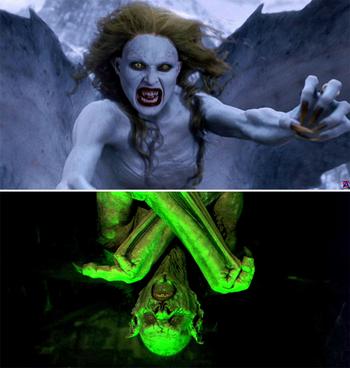

Stills from "Van Helsing" (2004) and "Bram Stoker's Dracula" (1992).
There are many fairy tales and legends about why bats began to fly at night.One of the funniest is Aesop's fable, where the Bat, along with the Cormorant and the Thorns, decide to organize their own business. The mouse borrows money, Ternovik supplies the company with clothing, and Cormorant - copper. But it so happened that the ship with the goods sank. Since then, the Cormorant dives into the sea, looking for copper, Thorns grabs those passing by by their clothes, and the Bat hides from creditors in the darkness of the night. Later this fable will be transcribed in verse by the Frenchman Jean de La Fontaine. Based on her motives, the Armenian poet Hovhannes Tumanyan will also write his poem "Unfortunate Merchants":
Since then, driven by shame, She no longer flies during the day. When the night falls quiet, Then our Mouse flies, - In the darkness it is easier for her to hide From the creditor and friends.
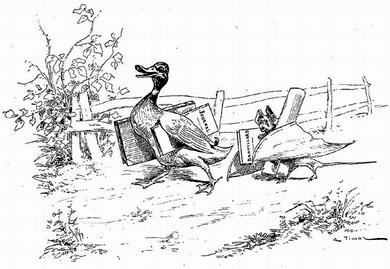

Illustration by de Vimard (1897) for Jean de La Fontaine's fable "The Bat, the Bush and the Duck".
Bat became the heroine of two other fables of Aesop. They play up another ancient idea of bats as creatures that occupy an intermediate position between animals and birds. So in one fable, the Bat, falling into the claws of two weasels, in turn convinces each of them to let her go: in the first case, declaring that she is not a bird, in the second, that she is not a mouse. And the moral is: "So we cannot always be the same: those who know how to apply to circumstances often avoid great dangers." A completely different moral is deduced from another Aesop fable, where during the war between birds and beasts, the Bat constantly moves from one camp to another, as soon as the advantage in the battle changes. After the war, this fact emerges, and Mice has to hide in the darkness of the night from both birds and animals. Moral: "He who seeks support from both sides, he lives in shame, rejected by both."
There is also a Greek legend about the three daughters of King Miny, who did not want to go to the orgy in honor of Dionysus, but stayed at home to spin fabric at night. As a result, the angry god turned the miniads into bats - since they really want to lead a quiet and secretive lifestyle.
Here we come close to the third group of associations associated with bats - secrecy, mystery, the ability to quietly and silently soar under the cover of darkness. It is not for nothing that in ancient Greece, bats often acted as a symbol of vigilance and discernment. For a long time, the image of this animal adorned the emblem of Soviet military intelligence and was accompanied by the motto: "The greatness of the Motherland is in your glorious deeds" (today the emblem of the Main Intelligence Directorate has been changed and instead of a mouse there is a two-headed eagle with a red carnation).
However, the Batman sign is better known worldwide. This character was invented in 1939 by artists Bob Kane and Bill Finger as a response to the popularity of Superman comics - the one with underpants over tights. No wonder at first Kane portrayed Batman in a similar leotard. But under the influence of Finger, the suit became more consistent with the name - completely black and as closed as possible. And instead of the original rigid webbed wings, Batman now has a more spectacular cloak.
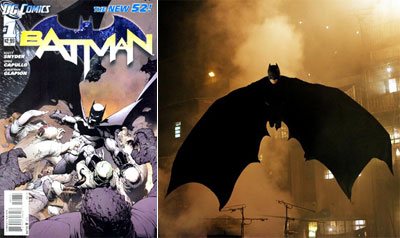

Bob Kane said that when he came up with Batman, he was inspired by the films The Sign of Zorro (1920) and Whisper of the Bat (1930).
From that moment on, a modest millionaire with a difficult fate has been secretly doing good not only on the pages of comics for more than 70 years, but also on movie screens.
In the famous operetta by J. Strauss, the bat costume also hides the true appearance of Rosalind - the heroine who manages to seduce her husband again in this outfit.
However, the secret nightlife is often directly related to vice. That was not slow to be reflected in the famous emigre song on the verses of Maria Vega. So vulgar that I can't listen to it without laughing:
After all, I am a schoolgirl, I am the daughter of a chamberlain, I am a black moth, I am a bat ... Wine and men are my atmosphere, The refuge of emigrants is free Paris!
But, perhaps, the most unexpected associations, the bat evokes in the Chinese.The fact is that the hieroglyphs for "happiness" and "bat" are written differently, but they sound the same - "fu". As a result of this phonetic incident, bats in China have become a symbol of happiness. In greeting cards, the image of five bats is especially popular, as a wish for five virtues - longevity, wealth, health, well-being and a worthy natural death.
| Alexey Tolstoy "Golden Key": "The bat squeaked again: - Wait for the night, Buratino, I will take you to the Land of Fools, friends are waiting for you there - a cat and a fox, happiness and fun." Joke: “They walk in the night of rats with a little rat. A bat flies by. Rat: - Oh, dad, look - the angel flew ... ". |
February 2020
How bats navigate in the dark
It's simple, bats "see with their ears." After all, they have such an amazing property as echolocation. How does it work? And so, animals emit ultrasonic waves that are reflected from objects and return back through the echo. Incoming feedback signals are carefully recorded by bats, thanks to which they are perfectly oriented in space and even hunt. Moreover, through the reflected sound waves, they can not only see their potential prey, but even determine its speed and size.
In order to emit ultrasonic signals, nature has provided bats with a special design with a mouth and nose. First, the sound originates in the throat, then it is emitted from the mouth and sent to the nose, radiating through the nostrils. The nostrils themselves have various bizarre outgrowths serving the formation and focusing of sound.
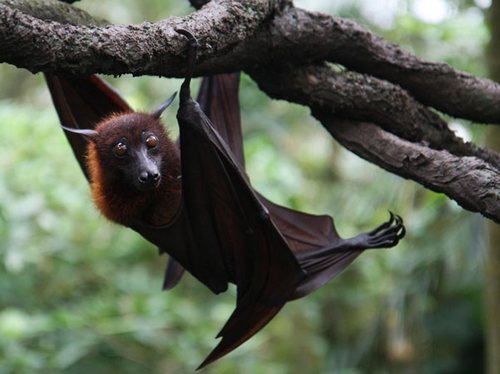

People can only hear bats squeak, because the ultrasonic waves emitted by them are not perceived by the human ear. An interesting fact: earlier, when humanity did not know about the existence of ultrasound, the amazing orientation of bats in pitch darkness was explained by the presence of those extrasensory abilities.
Echolocation ability
Bats detect objects blocking their path, emitting sounds inaudible to humans and catching their echoes reflected from objects. Before the discovery of ultrasonic echolocation, bats were thought to have extrasensory perception. They were deprived of the opportunity to use their eyesight, covered their wings with dense varnish to deprive them of the opportunity to feel air currents, and still they avoided obstacles located in the experimental chamber [2].
Research by Dr. O. Henson, an anatomist at Yale University, has shown that when scanning ultrasounds are emitted, muscles in bats' ears close the auricles to prevent damage to the hearing system. A well-known researcher of echolocation of bats was also the zoologist Donald Griffin [3].
During flight, bats sing songs using complex syllable combinations at high frequencies (due to their ability to echolocate). They create ultrasonic waves from 40 to 100 kHz. The call of the Brazilian folded lip includes 15 to 20 syllables. Taking care of the female, each male sings his own song, although in general the melodies of all songs are similar.
The difference lies in the individual combination of different syllables. Complex voice messages are used not only for courtship, but also to identify each other, designate social status, determine territorial boundaries, when raising offspring and when opposing individuals who have invaded someone else's territory.
According to biologist Michael Smotherman, no other mammal besides humans has the ability to communicate using such complex vocal sequences. The vocal center, which is responsible for organizing complex sequences of syllables, is located somewhat higher in bats than in humans, and scientists cannot yet determine exactly where it is located [4].
Echolocation signals in cubs develop from calling calls [1].
Bats that feed on fish (such as the Mexican fish-eating mouse) patrol the water surface at night, emitting very strong echolocation signals. However, these signals do not penetrate the water column. The mouse will not detect a fish under water, but will find it immediately if the fish sticks out even a small part of its body [1].
It should be noted that echolocation does not always help bats find food. It happens that some insects manage to hear the squeak of bats from afar and thus escape. And butterflies from the bear family send response signals to night hunters, with the help of which they indicate their inedibility or seek to hide their location by drowning out someone else's signal.
Echolocation of bats differs in different families. Horseshoe bats emit signals through the nose, and these signals are short (50-100 ms) ultrasonic bursts with a constant frequency of 81-82 kHz, but at the end of the signal the frequency drops sharply by 10-14 kHz. And smooth-nosed bats emit significantly shorter (2–5 ms) signals through the mouth with a frequency that during this time drops from 130 to 30–40 kHz [1].
Bats are able to detect wire obstacles at a distance of 17 meters. The detection range depends on the wire diameter. Wire with a diameter of 0.4 mm will be found from a distance of 4 meters, and with a diameter of 0.08 mm - from 50 cm. The wavelength of typical location signals of a bat is about 4 mm.
Of all bats, only flying foxes have eyes that can see anything in the dark; however, all bats hunt well at night. Their perfectly developed sense of smell, hearing and echolocation ability help them find prey - an amazing and perfect gift of nature.
Simply put, the bat acts like a radar. With its nose or mouth, it emits sounds inaudible to humans in the ultrasonic frequency range. These are short pulses with a frequency of 20-120 kilohertz and a duration of 0.2 to 100 milliseconds, which differ greatly in their parameters among representatives of different families.
This device is so perfect that some bats "see" wires less than 1 mm in diameter, and fishing mice - ripples raised by fish in the water.
We offer you to familiarize yourself with: Aquafumigator raptor from all types of insects
Some make sounds with their mouth and some with their nose. Intricate outgrowths on the muzzles aid in the directional propagation of sound.
Where do bats live?
They live practically all over the world, of course, with the exception of the cold Arctic regions. But most of them live in the tropics and subtropics.
Bats are nocturnal or crepuscular. During the day, they tend to hide in various shelters, both underground and above the ground. They are especially fond of caves, quarries, mines, they can hide in hollows of trees or under branches. Some bats even hide under the nests of birds during the day.
Bats usually live in small colonies - up to several dozen individuals. But there are colonies of bats and are much more populated, a colony of Brazilian folded lips is considered a record one, which can boast the presence of 20 million individuals. On the other hand, there are bats that prefer to lead a lonely lifestyle.
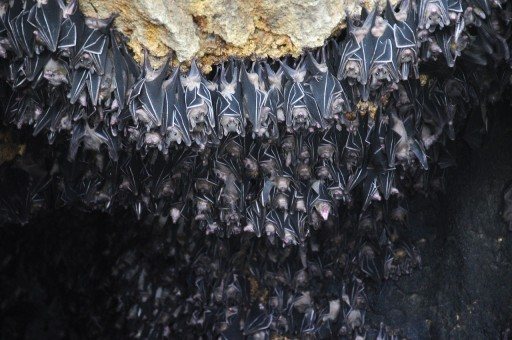

"Amrita cocoon" with lead
And yet, there is a popular belief about the Remez nest in the common people.
Kazakhs considered Remeza a sacred bird and did not even touch the nest with a finger
“As a child, we often saw rams hanging from nests in trees. The elders forbade us to even touch them with a finger. They were considered sacred. The curse of the whole family awaited those who spoiled their nest, ”the journalist wrote.
He explained why the "amrita cocoon" reacts to metal.
- Lead is poured into the cocoon and shown how it reacts to metal. This is pure fraud "
Why do bats sleep upside down?
It would seem a very strange habit of bats to sleep upside down, hanging on their hind legs, has very practical reasons. The fact is that this position allows them to instantly fly. To do this, you just need to unclench your paws. Thus, less energy is wasted and time is saved, which can be very important in case of danger. The hind legs of bats are designed in such a way that hanging on them does not require the expenditure of muscle energy.
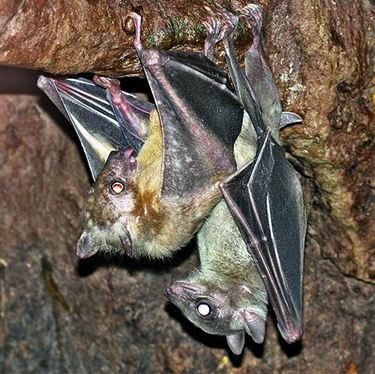

Sense organs
Bats' Response to Light: The bat's retina is devoid of cones, the receptors responsible for daytime vision.
Their vision is twilight and is provided with sticks. Therefore, during the day, animals are forced to sleep, because in daylight they see poorly.
In some representatives, the eyes are covered with bizarre skin folds. This once again confirms the hypothesis that mice are not guided in space with the help of a visual analyzer. Close relatives of bats, fruit bats, also belonging to the order bats, have cones. These animals can be seen during the day.
A secondary role for the animals of the visual analyzer was revealed in the course of a simple experiment: when the animals were blindfolded, they did not stop navigating in the environment. When the same thing was repeated with the ears, the mice began to bump into walls and objects in the room.
What bats eat
Most bats feed on insects, but there are also absolute vegetarians among them who prefer pollen and plant nectar, as well as various fruits. There are omnivorous bats that love both plant food and small insects, and some large species even hunt fish and small birds. Bats are excellent hunters, thanks in large part to their wonderful echolocation property we described above. Vampire bats, which feed exclusively on the blood of wild and domestic animals (however, they can also feast on human blood, stand apart), hence the name.
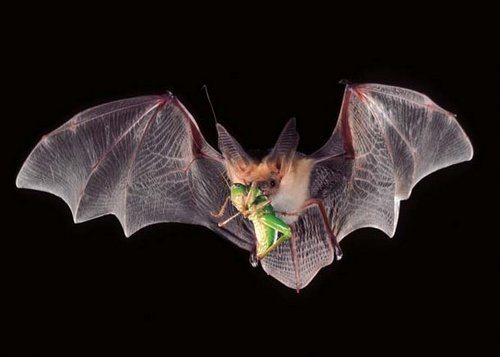

Structure
Birds have adapted to flight thanks to lightweight cellular bones, air sacs in the lungs and a cover that is heterogeneous in structure and function of feathers. Flying bats do not have all this, and the skin membranes can hardly be called wings.
How do bats fly? The flight of mice is similar to the flight of the flying machine of Leonardo da Vinci, who took over from nature the idea of the wing structure of a flying mammal.
A solid skin membrane impenetrable by air "covers" the air masses from above, which allows the animals to push off from them and fly.
Types of bats, photos and names
Here is a description of the most interesting bats in our opinion.
White leaf-bearing
Especially interesting for its appearance, yellow ears and nose against the background of white wool. Also differs from other bats in the absence of a tail. The white leaf-bearing is very small in size, its body length does not exceed 4.7 cm and its weight is 7 grams. Leaf-bearers live in South and Central America, preferring moist forests as their home. They are herbivores and feed exclusively on fruits. They live in small colonies of up to ten individuals.
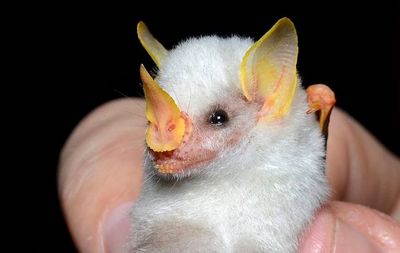

Giant nocturnal
The giant nocturnal is the largest bat found in Europe. The body length of the nocturnal reaches 10 cm and the weight is 76 grams. Has a brown coat. Vechernitsa usually lives in the forests, settling in the hollows of trees. You can also meet her on the territory of our Ukraine. It feeds on large insects, beetles,
butterflies. Also listed in the Red Book.
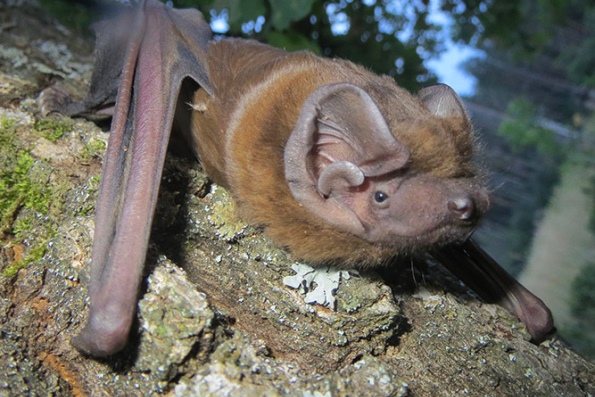

Pig-nosed bat
It is notable for the fact that it is the smallest representative of the bat family. Its length is only 2.9-3.3 cm, and everything is no more than 2 grams. However, it has rather large ears. The nose is very similar to the pig's piglet, hence the name of this species. The pig-nosed bat is often gray or dark brown in color.They live in Southeast Asia, especially a lot of them live in Thailand and neighboring countries. An interesting feature in the behavior of pig-nosed mice is their collective hunting. They hunt in groups of up to five individuals at night. Due to the small number, pig-nosed bats are currently listed in the Red Book.
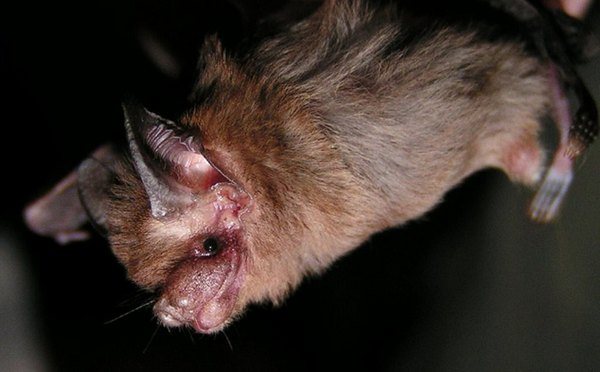

Two-color kazhan
This species got its name due to the color of the fur, which has two colors - the back is red or dark brown, and the belly is white or gray. The two-colored kazhan lives in a wide area: from England and France to the Pacific Ocean. These bats are found not only in natural conditions, but also in human cities, they can quite live in attics and eaves of houses. Night for them is the time to hunt for various small animals - flies,
mosquito, moth. Also endangered.
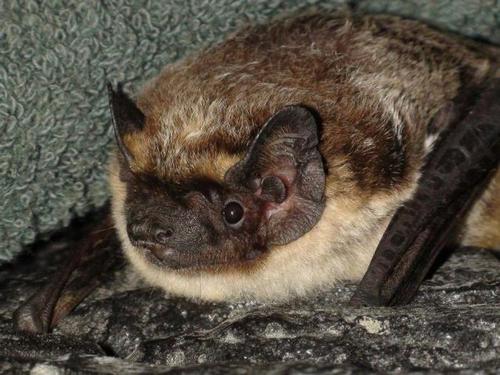

Water bat
She is Dobanton's bat, named after the French naturalist Louis Jean Marie Daubanton. It has a small size, its length is no more than 5.5 cm, and its weight is up to 15 grams. The color of the fur is usually dark or brown. The habitat is the same as that of the kazhan, practically throughout the entire territory of Eurasia. The life of the water bat is closely connected with water bodies (hence the first name), it is near them that they like to hunt, especially mosquitoes often become their prey, of which there are also many near ponds and lakes.
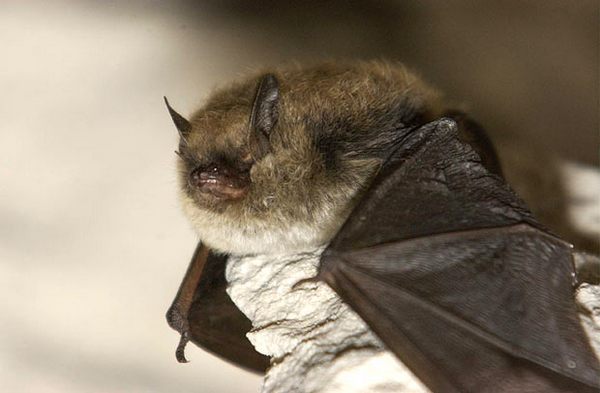

Brown long-eared bat
The long-eared bat is so named due to its amazing, by no means small, ears. The long-eared bat also inhabits the territory of Eurasia, but is also found in North Africa. They love to live in mountain caves, where they lead a sedentary lifestyle.
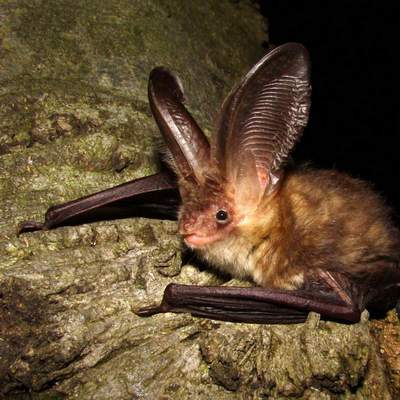

Bat dwarf
He is also a small-headed bat - the smallest representative of bats in Europe, its body length is no more than 45 mm, and its weight is up to 6 grams. His body is really very similar to the body of an ordinary mouse, only with wings. Also, this species loves to settle in places next to humans.
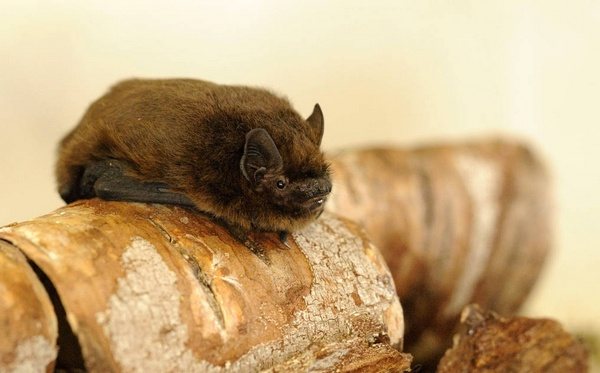

Big horseshoe
This species is mountainous, as it loves to settle in mountain caves, canyons, crevices. It inhabits a wide geographical area - Eurasia and North Africa, wherever there is mountainous terrain, you can find a large horseshoe bat. They hunt moths and beetles.
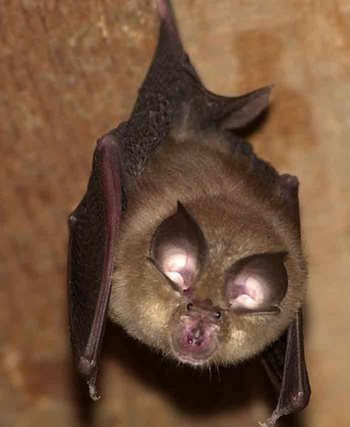

Common vampire
It is thanks to this species that bats, which are generally very useful in the ecosystem (at least by killing mosquitoes), have their own bad reputation. But an ordinary vampire actually, like the famous Count Dracula, feeds on blood, including possibly human. But as a rule, various pets become their victims and food base:
cows, horses, pigs. Vampires, as expected, go to their dark business at night, when their victims are deeply asleep. Imperceptibly sit on them, biting through the victim's skin, from which they then drink blood. However, the vampire's bite is inconspicuous and painless thanks to the special secret that they possess. But this is the danger, since the victim may die from blood loss. Also rabies or plague viruses can be transmitted with the bite of a vampire. Fortunately, vampire bats live only in the subtropics of Central and South America; in our latitudes, bats are absolutely harmless.
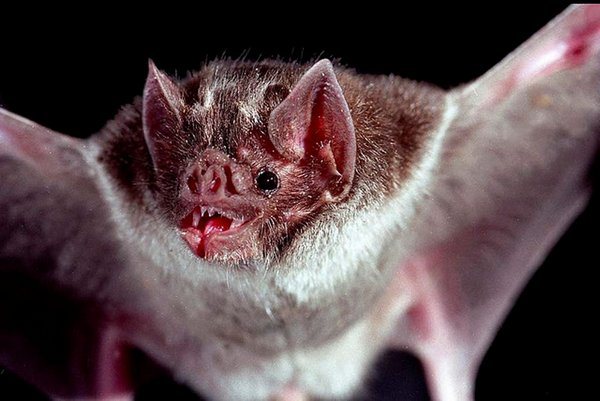

Character and lifestyle
Bats live in places where daylight hardly penetrates. These animals settle in large groups, sometimes the number of such a settlement can reach more than one thousand copies.
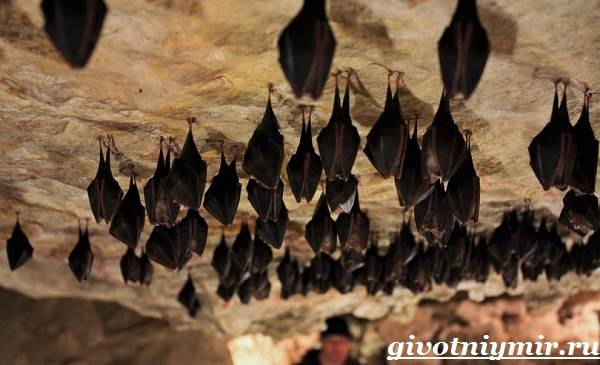

In the photo, a group of bats in a cave
Their homes are dark damp caves, hollows arranged in the trunks of large trees, abandoned cellars, in general, all places where you can hide from prying eyes. Bats are sleeping, hanging upside down, and wrapped in wings like a blanket. With the onset of dusk, the animals move out to hunt.
It should be noted that the bat not only moves well through the air, but also perfectly climbs steep surfaces, like an experienced climber, and can also move well on the ground, and if necessary, it can hover over the water for a while in order to catch from there fish delicacy. When mice fly, they always scream loudly. The sound of a mouse squeak is comparable to that of a jet engine.
Listen to the voice of the bat
If people could pick up ultrasonic waves, then it would be difficult to endure the screams of flying creatures, but simply unbearable. The cry stops only for a few seconds, while the mouse swallows the caught prey. Bats spend the winter in hibernation, and those who do not like to winter in harsh conditions fly away to warmer regions.
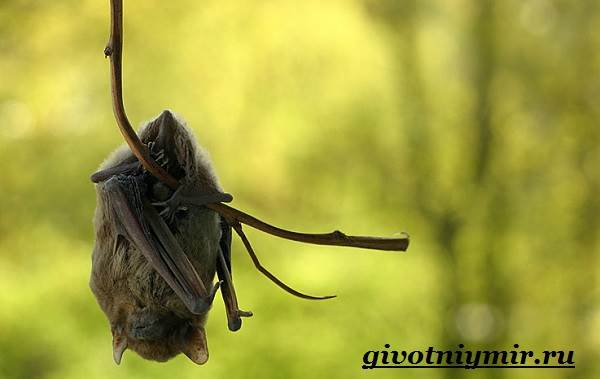

In the photo, the bat is sleeping
Nowadays, you can often meet people who like to keep exotic animals at home. By the price, sure, bat suitable for many average citizens, but the conditions of detention and food for the animal can result in a "pretty penny".
In addition, people need to know that if they make up their minds buy a bat, then do not expect that a quiet pet will come out of this animal.
In addition, it is not very easy to create acceptable living conditions, the same can be said about the diet, because mice do not eat everything, but only what they like.
Enemies of bats
Bats have their own enemies, which in turn can hunt them. Usually these are birds of prey: peregrine falcons, hobbyists,
hawks, and also owls. A snake, a marten and a weasel will also not mind grabbing a bat.
But the main enemy of bats (as well as many other animals) is, of course, man. The use of chemicals in crop production has significantly reduced the number of bats, many of the species are already listed in the Red Book, as they are on the verge of extinction.
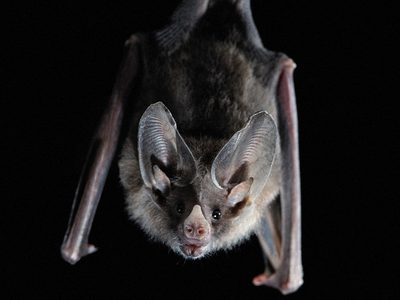

Flight
The arm with the wing is set in motion by several paired muscles of the upper girdle, which, to reduce energy consumption for flights, are attached not to the sternum, but to the fibrous base of the wing. The keel of the sternum of animals is inferior in power to that of a bird: only one muscle is attached to it, which is necessary for flight - the pectoralis major.
The flight speed of animals usually does not exceed 20 km / h. The Brazilian fold-lip is the record holder: its flight speed reaches 100 km / h. Some species are able to fly away for the winter, overcoming more than 300 km. Read about how bats hibernate.
The spine in flying mammals is more mobile than in birds. It allows mice to be more maneuverable outside the air.
Benefits of bats
But the benefits of bats are much greater:
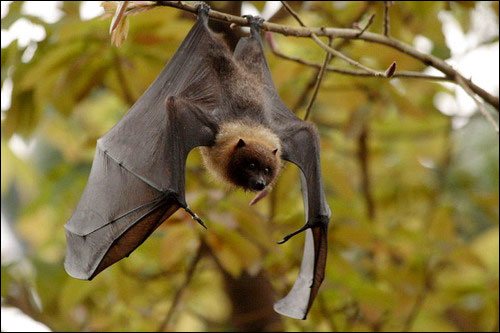

How to get rid of bats
But still, if bats have settled near a house, for example, under a roof, despite all their benefits, they can be annoying, especially because of their squeak. To get rid of bats under a roof, in a country house or attic, you need to follow these instructions:
- First, you will need to find a place where the bats rest during the day. Then, after waiting for them to fly off to hunt at night, just close this place with a tire iron or something else.
- You can try to smoke them out with smoke.
- You can spray their habitats with special sprays, whose smells will scare away mice.
Interesting facts about bats
- Bats always fly to the left of cover.
- Substances in the saliva of vampires are now used as drugs to prevent blood clots from forming.
- If in our culture bats are associated with vampires and other wickedness, in Chinese culture, on the contrary, they are symbols of harmony and happiness.
- The bat is very voracious, so in an hour it can eat up to 100 mosquitoes, in terms of human standards, this is about the same as eating a hundred pizzas in an hour.
Central Asia is also "in business"
It is worth noting that information about bat nest seekers was also disseminated in Kyrgyzstan and Uzbekistan. Uzbek conservationists fear that people are damaging the mammalian habitat by trusting false information on social media. The site centralasian.org writes about this.
In the Uzbek segment of social networks, information about the buyers of the nest for 5-10 thousand US dollars is being actively discussed.
In Tashkent, Anastasia Tashilova, an activist of the Living Planet Society for the Protection of Animals, is concerned about the destruction of mammalian nests. She urges people not to believe this false information and not harm nature.
- People believe this lie and destroy the habitat of bats. Do not become a victim of scammers, animals suffer from this, - Tashilova urges.
Bats videos
And finally, an interesting video about bats.


When writing the article, I tried to make it as interesting, useful and high-quality as possible. I would be grateful for any feedback and constructive criticism in the form of comments to the article. Also, you can write your wish / question / suggestion to my mail or Facebook, sincerely the author.
Popular science magazine Poznavayka

